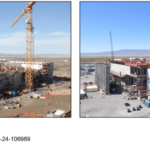More than seven years after New Hampshire regulators first approved the idea of using community solar to create savings for low-income households, electric bill discounts are finally on the horizon for the first batch of participants.
“There has been this rhetoric that we want solar to benefit low-income people, but whenever we try to propose programs that will make that happen, they’ve been immensely slow to roll out,” said Sam Evans-Brown, executive director of the nonprofit Clean Energy New Hampshire. “But despite being frustrated, I am really glad this is finally happening.”
The state energy department is reviewing seven proposals for community solar arrays that will allocate a portion of the credits they receive for sending power onto the grid to low-income households in the form of credits on their monthly bills. The projects selected will work with the utilities to identify customers receiving discounted rates, who will be automatically enrolled in the program.
Community solar is widely considered an important strategy for extending the benefits of renewable energy to people unable to take advantage of rooftop solar. Nationally, some two-thirds of households can’t install solar panels, generally because they don’t own their home, don’t have a suitable roof, or can’t afford the cost of the array, said Kate Daniel, Northeast regional director for the Coalition for Community Solar Access. Those obstacles are particularly challenging for low-income households, which are more likely to rent, need costly roof repairs, or lack the cash or credit scores needed to pay for panels, she added.
Community solar, on the other hand, allows these households to buy renewable energy, supporting climate action and saving money. Recent research from the Lawrence Berkeley National Laboratory found that community solar users have, on average, 23% lower incomes than rooftop solar adopters and are six times more likely to live in multifamily homes, suggesting community solar helps increase adoption of solar among these populations.
Why New Hampshire is important
Many states — including New Hampshire’s northeastern neighbors like Massachusetts and New York — have created programs to encourage the development of community solar projects that provide financial benefits to low-income households. But New Hampshire is falling behind: A recent report by the National Renewable Energy Laboratories, a federally funded research center, identifies New Hampshire as the state with the smallest share of its solar production going to disadvantaged households.
“We really have to ask ourselves why that is,” Evans-Brown said.
The first mandate for utilities to develop a program using community solar to benefit low-income households came as part of the order establishing the state’s current net metering system in 2017. Before a program could get off the ground, the state legislature passed a 2019 bill boosting the net metering rate for community solar projects serving low-income households, and the state suspended the earlier requirement until 2021, declaring it could be redundant given the new bill.
In 2021, the state asked for — and received — an additional suspension until July 2022, arguing that it had only finalized the eligibility rules for the net metering adder in September 2020, and therefore the utilities should not have to develop their own programs until the adder had a full two years to potentially spark development.
Then, in July 2022, the legislature passed a bill requiring the creation of a new community solar program including projects totalling up to six megawatts of capacity each year, each providing at least 25% of the credits it generates to low- or moderate-income customers. Customers will be automatically enrolled, but given ten days to opt out.
This program opened for proposals in December 2023, with a deadline of February 29, 2024. The state is now reviewing the seven proposals it received. If the applications total more than the six-megawatt cap, priority will be given to projects proposing greater benefits for low-income households.
“We are hammering out some of the final details with the utilities before we make the official designations,” said Joshua Elliott, director of policy and programs for the New Hampshire energy department. “Once we get the details of the processes finalized, we expect this process to move far more quickly in the future.”
‘To be determined’
There are elements of the program to like, advocates said.
Traditionally, it has been difficult for solar developers to cost-effectively find and recruit low-income customers for community solar. New Hampshire’s strategy of working with utilities to automatically enroll households that have already been identified streamlines the process. The state’s plan to review the program each year is also a strength, said Kirt Mayland, a visiting professor at the Institute for Energy and the Environment at Vermont Law and Graduate School.
Uncertainties remain, however. Enrolling customers from the utilities’ electric assistance programs may be more efficient for developers, but it runs the risk of missing a lot of low-income households that are eligible for the discounted rate but not signed up. To reach the largest possible number of potential subscribers, a program should also accept households enrolled in other means-tested programs, like Medicaid or SNAP, or even simply allow customers to self-attest their qualifying income.
“The evidence on states with self-attestation has found there is very little fraud — it really does get over the barriers,” said Daniel, who is not very familiar with the New Hampshire program but has worked extensively with community solar in best practices.
The small size of the program could mean small savings for each participating household, Mayland said.
“There’s a concern about how much money is actually getting placed on the low-income customer’s bill — sometimes it doesn’t blow you away,” he said. “It’s to be determined whether it’s an effective program to help out the low-income community in New Hampshire.”
New Hampshire’s low-income community solar program is finally nearing the starting line is an article from Energy News Network, a nonprofit news service covering the clean energy transition. If you would like to support us please make a donation.




